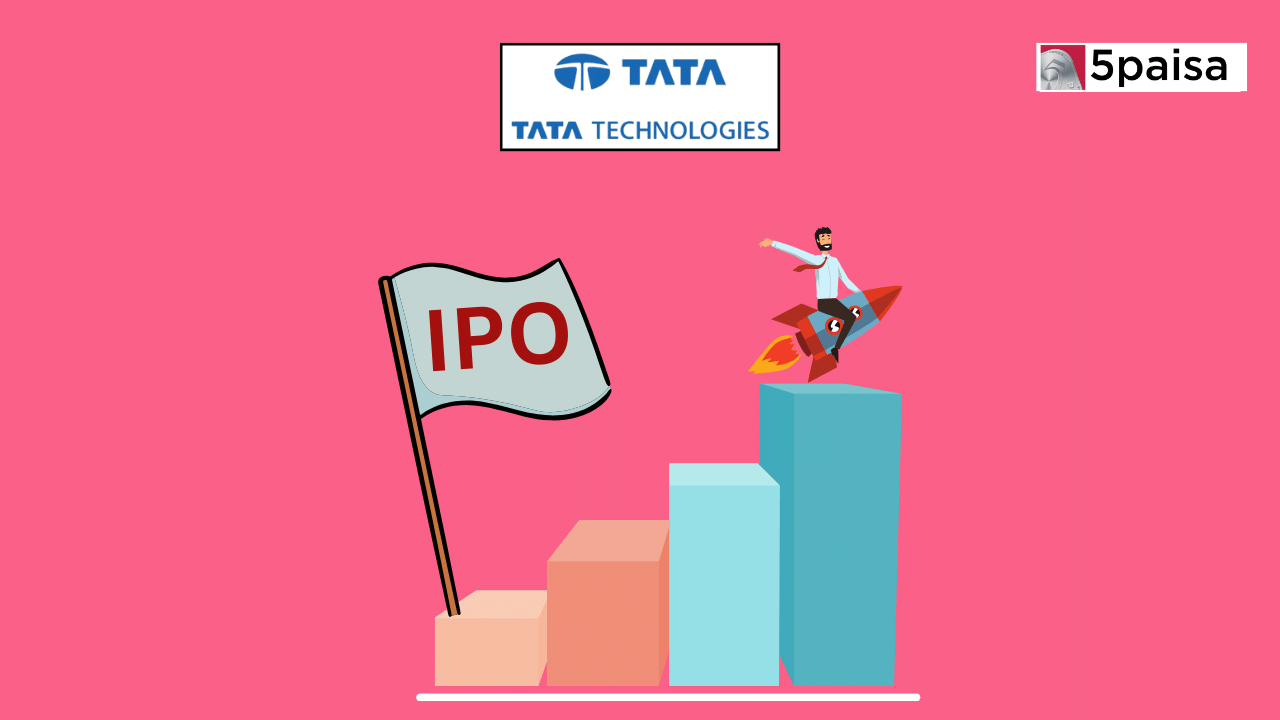Multibaggers Penny Stocks For 2025
Weekly Wrap-up: Tata Tech's Dazzling IPO Debut & the Tax Tale

Last Updated: 8th December 2023 - 11:03 pm
In the heart of the bustling Indian stock market, a tale of triumph unfolded on November 30th, as Tata Technologies made an awe-inspiring debut. The curtains lifted at ₹1,200 apiece on the National Stock Exchange (NSE), casting a premium spell of 140% over the issue price of ₹500 per share. This stellar entry marked the grandest listing since November 2021, echoing through the financial corridors with waves of excitement.
Investors who were fortunate enough to secure a piece of the Tata Tech IPO pie found themselves on a thrilling rollercoaster of gains. The stock, much like a soaring phoenix, continued its ascent, reaching a dazzling high of ₹1,400 apiece on both exchanges. In a mere blink, the investment had more than doubled, transforming dreams into tangible wealth.
Yet, amid the celebration of windfall gains, a shadow of responsibility loomed – the inevitable tax implications. For those who rode the Tata Tech wave to financial glory, understanding the tax journey became paramount.
Enter Balwant Jain, the Mumbai-based tax & investment expert, who shed light on the tax treatment of IPO gains. In this financial fable, Jain explained that the income tax rules applied to IPO gains align with the broader capital gains framework. However, there was a twist in this tale – the holding period would not commence from the date of investment but rather from the date of allotment of shares.
Nirav R Karkera, the Head of Research at Fisdom, chimed in with a crucial note for those revelling in short-term gains. He unveiled the taxman's demand, a short-term capital gains tax of 15%, ready to claim its share of the bounty. Karkera reassured investors that these gains could be offset against eligible previous short-term capital losses, creating a silver lining amidst the tax clouds.
But for those with registered businesses immersed in the art of investing, a different chapter unfolded. The gains, treated as business income, faced the scrutiny of applicable tax slabs, with incidental costs granted a deduction before the final taxation decree.
As our financial protagonists navigated the tax labyrinth, the capital gains tax rule emerged as a pivotal plot point. A holding period exceeding 12 months transformed the gains into the coveted long-term capital gains (LTCG), ushering in a more favorable tax climate. However, a shorter stint in the market – 12 months or less – cast the gains into the realm of short-term capital gains (STCG), a zone where a 15% tax awaited its share.
In this story of wealth creation & taxation, the characters were reminded that the tax department, like an omniscient guardian, kept a watchful eye on all transactions. The consequences of misreporting or under-reporting income could lead to penalties & financial perils, a cautionary subplot in the saga of riches.
Ans so, against the backdrop of Tata Tech's magnificent IPO debut, investors found themselves in a dual narrative – one of soaring gains & another of navigating the intricate tax tapestry. As the curtain fell on this chapter, the lessons learned from the Tata Tech tale would undoubtedly echo through the financial markets, guiding future investors in their quest for wealth & prosperity.
What’s so special about Tata Tech IPO? lets dig in the fundamentals:
Once upon a time in the vast realm of financial markets, there existed a company named Tata Technologies, a global engineering services provider with a tale as intriguing as its name. Let's embark on a journey through the financial landscape, exploring the company's essence encapsulated in a nutshell.
In a Nutshell: The Symphony of Quality, Growth, & Valuation
Picture this: a company with a harmonious blend of quality, growth, & valuation. Tata Technologies boasted a three-year average Return on Equity (ROE) & Return on Capital Employed (ROCE) standing proudly at 17% & 25%, respectively. A melody of positive cash flows echoed in the financial corridors for two out of the last three years.
Yet, amidst this symphony, a subplot unfolded. Trade receivables, a key character in the financial drama, claimed their space, constituting around 21% of the company's total assets in FY23.
The crescendo of growth was unmistakable. With a 36% annual growth rate in revenue & a staggering 62% in net profit over the past three years, Tata Technologies stood as a beacon of progress. A consistent operating margin of 15% added a touch of finesse to this financial masterpiece.
Valuation, the art of assigning worth, revealed an interesting plot twist. Priced at a P/E & P/B of 28.3 & 7.1 times, respectively, Tata Technologies seemed to dance to a different tune compared to its peers' median & average of 67.1 & 18.9 times, creating an aura of mystery around its true worth.
About the Company: Tata Technologies - Where Engineering Meets Innovation
In the year 1994, Tata Technologies emerged on the scene, donned in the garb of a global engineering services provider. Its primary patrons? The automotive original equipment manufacturers (OEMs). With two revenue verticals – services accounting for 80% of FY23 revenue & technology solutions making up the remaining 20% – Tata Technologies played a pivotal role in outsourced engineering & digital transformation services.
But that's not all; the company had a dual identity. A fraction of its revenue stemmed from reselling third-party software applications & services to educational institutions, adding a layer of diversity to its narrative.
Strengths: A Solid Foundation in Clientele Loyalty
The story took an uplifting turn as Tata Technologies unveiled its strengths. With clients like Tata Motors & its illustrious subsidiaries, including the renowned JLR, the company boasted a clientele that was the envy of its peers. A remarkable customer repeat rate of over 97% as of September 30, 2023, showcased the enduring relationships Tata Technologies cultivated in the services segment.
Weaknesses: The Tale of Dependence & Cyclicality
However, the narrative wasn't without its challenges. A dependency on Tata Motors, with 55% of FY23 revenue tied to its fate, unveiled a vulnerability. The cyclicality of the automotive industry, contributing to 71% of FY23 revenue, exposed the company to the whims of macro volatility. Moreover, as a significant portion of revenue (65% in FY23) arrived in foreign currency, the plot thickened with the looming uncertainty of exchange rate fluctuations.
As the story unfolded, Tata Technologies emerged as a protagonist in the epic saga of financial markets, weaving a tale of quality, growth, & valuation intricately entwined with strengths & weaknesses. Only time will tell what lies ahead for this enigmatic character in the ever-evolving world of finance.
| M-cap (Rs cr) | 20283 |
| Net worth (Rs cr) | 2853 |
| Promoter holding (%) | 55.4 |
| Price/earnings ratio (P/E) | 28.3 |
| Price/book ratio (P/B) | 7.1 |
You must be having many Questions about the Tata Tech Ltd., Let’s roll in
Company & Business
Question - Has Tata Technologies earned more than Rs 50 crore in the last 12 months?
Answer - Yes, Tata Technologies' profit before tax in the trailing 12 months is Rs 921 crore.
Question - Can Tata Technologies scale up its business?
Answer -Yes, the increasing demand for next-gen technologies, especially in the automotive sector, is expected to drive higher spending in engineering, research & development, facilitating the company's expansion.
Question - Does Tata Technologies have recognizable brands & client loyalty?
Answer -Yes, the Tata Group's strong brand & enduring relationships in the services business, with a customer repeat rate of over 97%, contribute to its brand recognition & client stickiness.
Question - Does Tata Technologies have a credible competitive advantage (moat)?
Answer -No, it faces significant competition from established players like L&T Technology Services & KPIT Technologies.
Management
Question - Do any founders hold at least a 5% stake in Tata Technologies post-IPO?
Answer -Yes, promoters will retain a 55.4% stake post IPO.
Question - Do the top three managers have more than 15 years of combined leadership at Tata Technologies?
Answer -Yes, Kevin Harris, the CEO, has been associated with the company since 2005.
Question - Is the management trustworthy & transparent?
Answer -Yes, there's no information suggesting otherwise, but SEBI issued a warning in 2020 regarding compliance with regulations after an investigation in 2018.
Questions - Is Tata Technologies free from promoter pledging of its shares?
ANSWER - Yes, the company is free from promoter pledging.
Financials
Question - Does Tata Technologies have strong financial performance?
Answer - Yes, with a three-year average ROE & ROCE of 17% & 25%, respectively. The current 12-month ROE & ROCE are 27% & 32%.
Question - Was Tata Technologies' operating cash flow positive in the last three years?
Answer -No, it reported negative operating cash flow in FY22.
Question - Is Tata Technologies free from significant debt?
Answer - Yes, it is net cash positive as of September 2023.
Question - Can Tata Technologies run its business without relying on external funding for the next three years?
Answer - Yes, it's a profitable business & has generated positive cash flows in two of the last three financial years.
Question - Is Tata Technologies free from meaningful contingent liabilities?
ANSWER - Yes, contingent liabilities as a percentage of equity are 1.0%.
Valuations
Question - Does Tata Technologies offer a high operating earnings yield?
Answer -No, the stock will offer a 4.1% operating earnings yield on its enterprise value.
Question - Is Tata Technologies' stock price favourable compared to peers?
Answer - Yes, with a P/E ratio of 28.3 compared to peers' median of 67.1 & a P/B ratio of 7.1 compared to peers' average of 18.9, the stock seems attractively valued.
Conclusions
Tata Technologies presents a compelling profile with robust earnings exceeding Rs 50 crore, potential for scalability amid the demand for next-gen technologies, and a recognizable brand bolstered by strong client relationships. While lacking a distinct competitive moat, the management's trustworthiness and a founder stake post-IPO add credibility.
Financially sound with positive return metrics, the company faces challenges such as negative operating cash flow in FY22. Valuation-wise, it offers relative attractiveness against peers. As investors navigate this financial plot, Tata Technologies emerges as a protagonist with growth potential, yet the nuances demand a cautious eye on dependencies and financial intricacies in the unfolding chapters of its market journey.
- Flat ₹20 Brokerage
- Next-gen Trading
- Advance Charting
- Actionable Ideas
Trending on 5paisa
Indian Stock Market Related Articles
Disclaimer: Investment in securities market are subject to market risks, read all the related documents carefully before investing. For detailed disclaimer please Click here.
 5paisa Research Team
5paisa Research Team
 Sachin Gupta
Sachin Gupta




